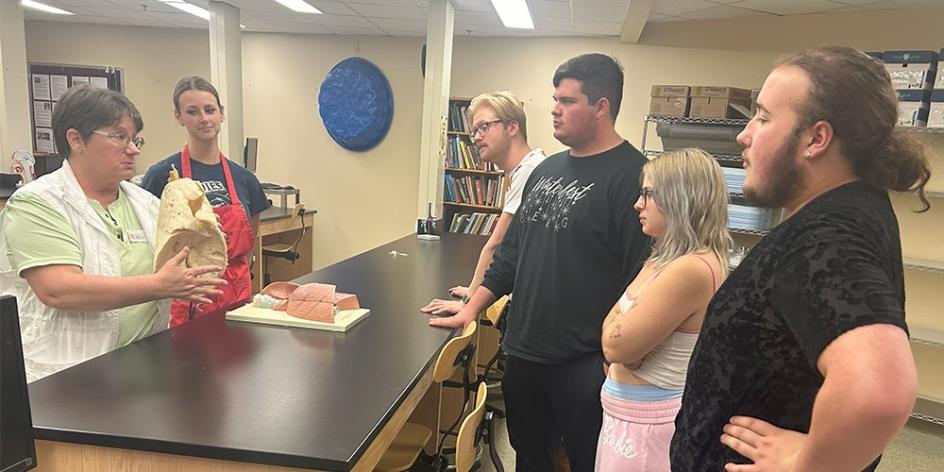
Music majors at Heidelberg often find themselves camped out at Brenneman Music Hall for long days and nights of classes and rehearsals. It’s their home.
Bio majors at Heidelberg often find themselves camped out in Bareis Hall of Science for long days and nights of classes and labs. It’s their home.
Last week, the two “camps” came together when Dr. Carol Dusdieker took her Vocal Pedagogy class to the George Barlow Body Donor Lab (also known as the Cadaver Lab) for a tour of the lab and an experience the music majors won’t soon forget.
'Amazing opportunity'
Coordinated by Biology Professor Dr. Pam Faber and led by tour guide and Teaching Assistant Kiara Grow, a senior biochemistry major, students had a chance to see demonstrations of the diaphragm, the larynx and vocal cords, abdominal muscles, and lungs with respiratory passages.
“As singers, our body is our instrument,” Carol said. “The cadaver lab tour gave students the opportunity to engage with the body in ways not possible in a classroom setting. They can feel the diaphragm, track the movement of the breath from mouth to lungs and see and feel the elements of the larynx.
“What an amazing opportunity for our School of Music & Theatre students!”
Senior Music Education major Cole Miller, who participated in the cadaver lab tour, agreed.
“Going to the lab helped me improve my knowledge of vocal pedagogy overall. It helped me understand why the body does what it does,” he said. “So many times when singing, we think, ‘Well, why is this happening or I can’t do that.’” But the lab tour helped me reassess those thoughts.”
Beyond hands-on
While the students benefitted from the hands-on experience in the mechanics of singing, there were some intangible benefits too. Carol recognizes the value of the lab as a unique resource for HU science students. She also appreciates the commitment to collaboration. “Our School of Music & Theatre students were able to connect to vocal anatomy and function directly with a human body, making their coursework and instrument come to life,” she said.
The student-to-student connection also is priceless. Kiara, as an advanced student in Pam’s Anatomy & Physiology class, was able to take a leadership role in demonstrating the anatomical structures, and she was delighted to share one of Heidelberg’s resources that has meant so much to her in her preparation for medical school.
“Being able to host the Vocal Pedagogy class in our lab was a wonderful experience,” she said. “I saw how deeply our donor bodies have impacted the lives of others outside of those who are in the anatomy and prosection courses.”
Kiara herself has been deeply impacted by having the lab on campus – so much so that it was her primary reason for enrolling at Heidelberg.
A valuable resource
“To me, the donor body lab is one of Heidelberg's most important resources. … Being in the lab and working with the donor bodies alongside my peers has been the highlight of my time here. It is an invaluable source of learning that many students in other universities do not have access to, let alone being able to share with other areas of study.”
There’s no debate about the value the cadaver lab to ‘Berg students. Through the generosity of The Ohio State University and its body donors, “We are blessed with the very best platform for anatomical instruction,” Pam said. It’s been the highlight of Kiara’s time as a student.
“It has been my home and a favorite place for the past two years here at Heidelberg,” she said. “This experience has furthered my understanding of just how important the lab is to many people.”
The Vocal Pedagogy class is now among them.
“Dr. Faber and Kiara were so very welcoming for us, especially since the science building isn’t our normal ‘home,’” Cole said. “The environment was something that I had never experienced before and I would love to go back.”